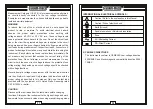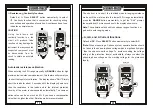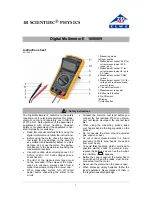
®
®
13
14
Analog bar-graph
The analog bar graph provides a visual indication of measurement
like a traditional analog meter needle. It is excellent in detecting
faulty contacts, identifying potentiometer clicks, and indicating
signal spikes during adjustments.
RMS (Root-Mean-Square) is the term used to describe the effective
or equivalent DC value of an AC signal. Most digital multimeters
use average sensing RMS calibrated technique to measure RMS
values of AC signals. This technique is to obtain the average value
by rectifying and filtering the AC signal. The average value is then
scaled upward (calibrated) to read the RMS value of a sine wave.
In measuring pure sinusoidal waveform, this technique is fast,
accurate and cost effective. In measuring non-sinusoidal
waveforms, however, significant errors can be introduced because
of different scaling factors relating average to RMS values.
Average sensing RMS calibrated
True RMS is a term which identifies a DMM that responds
accurately to the effective RMS value regardless of the waveforms
such as: square, sawtooth, triangle, pulse trains, spikes, as well as
distorted waveforms with the presence of harmonics.
True RMS
Harmonics may cause :
1) Overheated transformers, generators and motors to burn out
faster than normal
2) Circuit breakers to trip prematurely
3) Fuses to blow
4) Neutrals to overheat due to the triplen harmonics present on
the neutral
5) Bus bars and electrical panels to vibrate
3) PRODUCT DESCRIPTION
Panel Illustration
1) 3-4/5 digits 5000 counts
LCD display.
7) Input Jack for milli-amp and micro-amp current functions
2) Push-buttons for special
functions & features.
3) Selector to turn the
Power On or Off and
Select a function.
4) Input Jack for 10A (20A
for 30sec) current function
5) Input Jack for all
functions EXCEPT current
(
m
A, mA, A) functions
6) Common (Ground
reference) Input Jack for all
functions.

































